
 |

|
|
|
|
Height:
5' 7" - 5' 9"' (1,70 m - 1,75m) Weight: 129 lbs (58 kg) Hair: brown - light blond Eyes: blue Marriages: (1) Louis Butterman, musician (Aug 16. 1937 - Jun 1945, divorced) (2) Jaime Carrillo del Valle, Air Force Major, radio producer-director (Oct 15. 1947/ Apr 8. 1948 * - Dec 22. 1959, divorced) Sons: Gregg Bandini (Nov 11. 1948 - Sep 30. 2001) Jaime Carrillo Jr. (Mar 10. 1951 - ) Ricardo Bandini (Aug 17. 1953 - Jul 13. 2012) (3) Flavius Otto Burket (Aug 12. 1962 - Apr 25. 1965, his dead) |
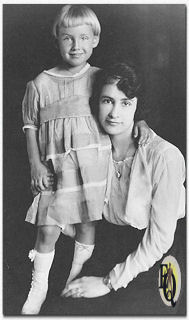 |
| Above right: Virginia & Dewey Gregg, ca. 1920. | |
|
Born March 6. 1916 as Virginia Lee Gregg, in Harrisburg, Illinois; daughter (and only child) of Edward William Gregg, a businessman and Dewey Alphaleta Todd, a musician. The family in Harrisburg was close. Virginia lived with her parents a 325 E. Locust street where a historical marker honoring her stands today. Her home backed up to here paternal grandparents' home on E. Poplar Street. After the death of her maternal grandfather, Hugh Todd in 1919, when Virginia was three years old, "Grandma Luella" aka "Tennessee Todd" came to live with Virginia and her parents. She had one grandparent in the living room and from her backyard, could peek through the fence slats alongside the chickens and see her other grandparent's towering mansion. Many of her aunts and uncles lived within blocks of each other around the square that housed many of their family owned businesses. They did life together daily, with church practices, Sunday suppers, and songs around the family piano. Harrisburg was a happy place and many loved "little Ginny Lee Gregg." (8) As an only child, Virginia and her mother, Dewey, were very close. She was Virginia's caregiver, playmate, companion, and ever-present anchor, while Edward was the pragmatic. Virginia admired her father but her mother was her solace. In 1921 when Virginia was 5, Dewey was diagnosed with "consumption" or tuberculosis. In the 20s often a slow death sentence. Just shy of a year after Dewey's diagnosis, the Greggs packed up their home and with six year-old Virginia in tow moved to California. It was a pilgrimage to the hope of prolonged life. California was a mythological beacon of sorts for those with incurable ailments including consumption. Certainly a difficult decision to bid farewell to many family members they would never see again. Grandma Luella stayed behind and moved in with other Harrisburg relatives. The three loaded what they could and bade farewell to family and neighbors and made the 1,937 mile journey. They boarded the Californian in Chicago and arrived after days in Altadena, California. There was a Saline Country family who made a similar migration to California. (8) Her father worked in the absorption plant of an oil company Richfield Oil on Signal Hill, where he would work for 22 years. Dewey was functional enough at the beginning of their California move to go about some of her normal house duties and within the community. From 1922 to 1935, the Greggs moved from house to apartment to bungalow to boarding house with one change of address after the other, all within a ten-mile radios. Biographer Bailey (8) suspects these moves may have been in part due to landlords or neighbors discovering Dewey's condition through the persistent cough, which back then could cause a panic. For fear that Edward or Virginia might be infected, there were rigid protocols the family followed, from separate beds, dishes, and personal effects. As Dewey weakened, Virginia assumed more and more of the household responsibilities. Edward's focused on providing for his family, with little consolation for his young daughter's grief. School was Virginia's solace, for at school, she could be what she was: a kid. She had two distinct trainings: school and home life. (8) Virginia enrolled in the John Fremont Grammar School at Fourth St. and Termino Ave., Long Beach. It was while in the seventh grade at Jefferson Junior High that Virginia remembers having the most fun. She loved sports and excelled as pitcher on the baseball team. Her specialty was a fast curve and Long Beach teenagers had their own particular version of the tragedy of Casey-at-the-Bat when they stepped to home plate to face the blue-eyed Gregg gal with the super-duper pitch. She also enjoyed swimming, basketball, tennis, and track.
After the
first few years in Altadena,
Edward's young brother Roy,
joined them with his wife Ollie
and their children William,
Helen and Dorothy. Virginia was
great friends with first cousins
Helen and Dorothy who were close
in age. When Virginia was nineteen when Dewey Alphletta Todd Gregg died on June 13. 1935, at the age of thirty-seven. She lived 13 years beyond the consumption diagnosis which was quite remarkable in those years. After Dewey's untimely death Virginia treasured her mother's jewelry, proudly wearing many of her pieces as parts of her every day. In several prints or productions a ring of Dewey's can be seen on Virginia's left pinky. She also wore her mother's cameo necklace and single dangling pearl until her own death. (8) Virginia's way of life changed drastically with the death of her mother.
They lasted for a five-year run, with Virginia present for the first four. They cut several records, were presented at the Hollywood Bowl, performed with idols of the day and were hired as staffers for two different networks: CBS and Mutual. |
|
| Above right: Young Virginia Gregg part of The Singing Strings. | |
|
It was through her work at Mutual that she did a few on-air commentaries and MC spors that led to her ultimate decision to break away from the music business and pursue acting fulltime. Virginia became enamored with a fellow symphony musician Louis "Lou" Butterman, tall, dark, handsome and eight years her senior. Lou was an impressive 6'1 at 195 pounds when Virginia met him, with brown eyes behind his glasses, brown hair, and an olive complexion. Lou, recently divorced, fell in love with the slender, dark-haired beauty.
Shortly after Dewey died her father remarried Gertrude
Dooley Harris, a divorcee 12 years younger than Edward and only 14
years older than Virginia. Gertrude also had a young daughter 4 years older than
Virginia. |
|
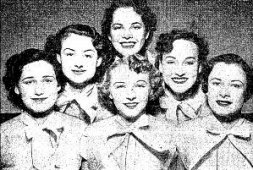 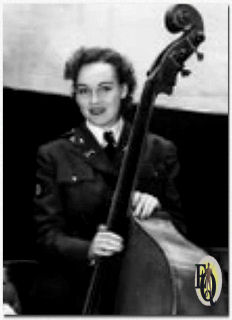 Above left: Virginia (Second row, right) joined up with 5 other young female musicians. They called themselves "The Singing Strings". The group organized in 1936 with Harriet Wilson as leader and first violinist, Evelyn Hirsch and Josephine Harvey also as violinists, Catherine Ames as celloist, Leone Turnbow as pianist, and Virginia Gregg as double bass violist. The troupe was under the direction of Dr. Leonard Stallcup. Above right: Virginia with the bass viol. |
|
|
Though she loved music she had dreamed of being an actress. In 1938 Virginia played twenty shows a week at the studio and had to rehearse for all of them, but she still managed to find enough time to play a few small parts and one lead at the Playhouse. Then, one day, while her orchestra was rehearsing the music bridges for a dramatic show at the studio, the leading lady called up to say she was too ill to make the broadcast. The director tore his hair. He couldn't find a replacement at the last minute. Virginia had listened to enough rehearsals to know the script and she asked if she could read it. The director didn't like the idea, but there wasn't anything else for him to do, so he gave her the script. Virginia played the part on the air, taking her cues from a very nervous director, indeed. It wasn't until after the broadcast that she had time to tell him about her acting experience. Virginia credits Calling All Cars as being the first radio show she appeared in regularly. She most likely joined it in the late 1930s. Around 1941 other radio worked followed...
"I was also on staff at KHJ. I broke into acting there. I
narrated one of our shows. Then they started using me on Johnny Nesbitt's 'The
Passing Parade'. If they needed a character, a voice, I did that. Then I did
'Rise and Shine', an early morning show with Jimmy Burton and Sam Pierce."
Having been musically trained she learned to use her voice as an instrument. With help of dialect coaches she could do any accent the script called for. Her versatility as a character actress and knack for cold reading on the air made her a hot commodity. Parley Baer, dear friend and nearly lifelong colleague, once joked that Virginia was the main cause of the spoke in unemployment rates in the 1940s because she hogged most of the radio jobs. In 1941, she built a home in the Los Feliz district and furnished it in modern Chinese. "I'd rather spend a quiet evening there than brave crowded night clubs," she confessed. Not a bachelor girl, Ginny shares her home with a cousin and a fourteen-pound black Persian cat, Abdul. "It's Abdul who's lord and master there. He thinks it's his house." When Lou was drafted into the United States Coast Guard, a Harrisburg cousin moved in with Virginia and her cat. Virginia volunteered her spare time to the war effort and became very dedicated to veteran's affairs. When Lou returned from his service in 1944, the relationship he and Virginia had didn't seem to work any longer. They did move from Echo Park to a brand new California bungalow on the flip side of East Hollywood with Lou's widowed mother. In June of 1945 they divorced. |
|

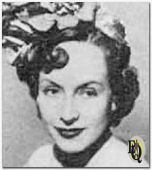 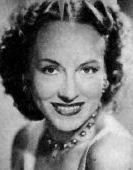 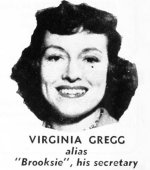 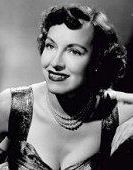 |
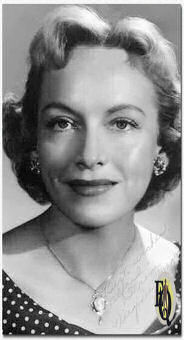 |
|
Top left: Promo for The Count of Monte Cristo. This
adventure drama based on Alexandre Dumas' novel had a run on the West Coast
(1944 - 1945) and then on Mutual between 1946 and mid-September 1949. Directed by
Jaime del Valle it had Carleton Young as Dantes, Parley Baer as Rene and also
featured William Conrad, Jay Novello, John Dehner and Virginia Gregg... Top middle: Virginia Gregg in 1946. Right: Virginia wore her mother's cameo necklace and single dangling pearl until her own death. Above left: She played secretary "Claire 'Brooksie' Brooks" opposite actor Bob Bailey (detective "George Valentine") in Let George Do It on Mutual from 1949 to 1954. Above middle: Publicity shot for Virginia as Brooksie in radio's Let George Do it. Francis Robinson first played Brooksie, then Virginia Gregg took the role through its best years. Both ladies played Brooksie smart and sassy. |
|
In 1945 she played a while in the Michael Shayne radio series. In the 1940's Virginia seemed to be in all the shows on the air! Her specialties appeared to be westerns (mostly in movies) and "who-dun-its" (both radio and movies) although she was "Betty" on the Granddad of all soaps One Man's Family (NBC) for 9 years. She also turned up on the popular medical series Dr. Kildare (MGM Syndication) and the beloved Lum and Abner series. She played secretary "Claire 'Brooksie' Brooks" opposite actor Bob Bailey (detective "George Valentine") in Let George Do It (Mutual, 1949 - 1954). What George did was offer to clear up cases for other people who found them too tough to handle. In the Summer of 1946 Prevention Preferred, was presented in cooperation with the 10th District Parent - Teachers Association. The dramatic programs were presented by a cast which included some of Hollywood's topflight actors. Frequently heard are Conrad Binyon, Virginia Gregg, Leone Le Doux, Tyler McVey, and Ted Von Eltz. Throughout the summer the program stressed disease prevention and safety precautions as they apply to playgrounds and camps, as well as psychological guidance work of playground supervisors in teaching youngsters to get along with each other. Being an movie actress was the ultimate for any acting hopeful. Her first film was Notorious (RKO Radio Pictures, Aug 15. 1946), directed by Alfred Hitchcock in which she had a non-credited background role as "file clerk", followed the next year by similar background roles in Leigh Jason's Lost Honeymoon (Eagle-Lion, Mar 29. 1947) and Elia Kazan's Gentleman's Agreement (20th Century Fox, Nov 11. 1947) with the elegant Gregory Peck. Body and Soul (United Artists, Nov 6. 1947) with the charismatic John Garfield, she herself considered her true start thanks to colleague William Conrad. |
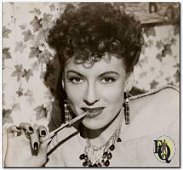 Back to the "gumshoes" as of November 1947 Virginia starred briefly as secretary "Nikki Porter" with Larry Dobkin who filled the title role in The Adventures of Ellery Queen (CBS). Right: Promotional photograph for Virginia Gregg in the 40s radio series Ellery Queen. |
|
The Anderson Family broadcast from 1947 - 1948 was a situation comedy radio program billed as a "Hollywood Broadcaster's Production". In this enjoyable family program Virginia played Mary, wife and mother next to well actors such as Conrad Binyon and Charlie Lung. Healing after her marriage wasn't easy but she blossomed in her new career. About a year after her divorce another man came into her life. Jaime del Valle was an esteemed director and producer. They had already met during Virginia's musician days, but she was the only one remembering their introduction. Upon his return from service during his direction of radio's adaptation of Cisco Kid, the two were reintroduced in a different context. "I don't remember if I took her out to dinner that night or not, but shortly after that we were married," Jaime recalled. They married in Las Vegas, April 8. 1948 s. The two seemed a splendid match and bought a sizeable Los Angeles villa less than a mile from Sunset Blvd and settled in. (8) |
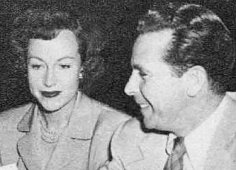
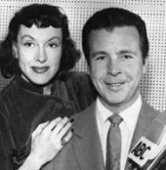 Above left: Preliminary run-through of a script for Richard Diamond, Private Detective. Virginia Gregg (Helen Asher) and Richard Powell (the detective), see what Diamond's up to today. Above right: Dick Powell and Virgina Gregg during the ABC run of Richard Diamond from KECA Studio X in Hollywood. |
|
On October 10. 1948 Virginia's father died. Just a month after Edward's death Virginia gave birth to her first child on November 11. 1948. She had continued working until a week before giving birth and also went back to work quickly afterwards. She was "Helen Asher" to Dick Powell's Richard Diamond, Private Detective on NBC-Radio from 1949 to 1952 then on CBS-Radio for the 1952 - 1953 season. "Helen" was the filthy-rich Park Avenue gal who was always trying to lure Diamond up to her gorgeous digs, where, if he ever did have time to get there he would head for her baby grand and burst into song! Virginia also guest-starred on The Adventures of Philip Marlowe (CBS Radio, 1948 - 1951) starring Gerald Mohr... (Dick Powell was actually radio's first "Marlowe") for which Mohr, in 1950, was named Best Male Actor on Radio by Radio and Television Life Magazine. Virginia was also "Betty Lewis" or lady Alice Merrick on the radio series Yours Truly, Johnny Dollar (CBS, 1950 - 1956) yet another "tec" series under production of Jaime Del Valle. Their second child Jaime was born on March 10. 1951 and Ricardo was born on August 17. 1953 all births heavily publicized in the newspapers. Virginia played hundreds of roles on NBC radio and some of her best came through her joining actor/director/producer Jack Webb's stock company as a result of which she was heard in one role or another about every other week on radio's well-received Dragnet. She was also starred in the two Dragnet films that were eventually made in Hollywood and also in the TV series by the same name (NBC, Feb 28. 1952 - Sep 1. 1955, min. 10). |
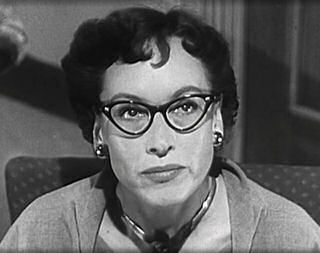
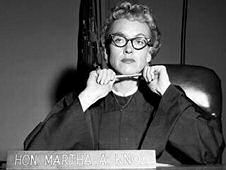 Above left: Virginia Gregg in Dragnet "The Big Show" als Marjorie Lewis (NBC, Jan 22. 1953) Above right: In Public Defender (CBS, Jan 27. 1955) she played the role of Hon. Martha A. Knox. |
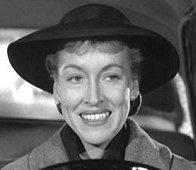
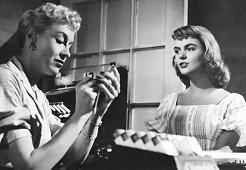 Above left: Virginia in Alfred Hitchcock Presents as Miss Clementine Webster in the episode "Santa Claus and the Tenth Avenue Kid" (CBS, Dec 18. 1955). Above right: As Clara Madison in the movie Portland Expose (Allied Artists Pictures, Aug 11. 1957) with Carolyn Craig. |
|
Virginia appeared many times on the radio and TV version of Have Gun, Will Travel (CBS, Nov 1. 1958 - Mar 10. 1962, min 2) opposite the fine actor John Dehner who starred as "Paladin". Oddly enough this show originated on CBS-Television (1957 - 1963) as a starring vehicle for Richard Boone and was such a smash that CBS decided to develop it for CBS-Radio (1958 - 1960) as well. Generally this worked the other way around: from radio to TV! Besides being a well-rounded actress she could also manage dialects. From an Irish brogue to a Chinese "ah, so". Directors and producers delighted in her ability and dedication to her profession. Often she was in several shows at virtually the same time and managed them all. Where she found the time to marry and raise 3 sons remains a mystery. In October 1958 riding his bike down the street Jaime was hit by a car. Virginia was one of the first to be called to her son still in the wreckage. Jaime recovered, after multiple lengthy hospitalizations and many restorative procedures. After ten years of marriage Virginia filed for divorce in 1958 on the grounds of "grievous mental and physical cruelty". Jaime moved out the Parkwood Drive home while she and the boys remained until the divorce was final on December 22. 1959. According to the court record, the restraining order was necessary because Jaime felt comfortable coming back "home" whenever he wanted. |
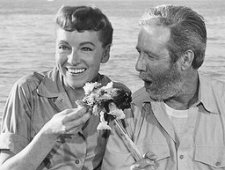
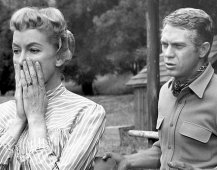 Above left: Virginia with Arthur O'Connel in Operation Petticoat (Universal, Dec 3. 1959). It also featured Cary Grant and Tony Curtis in a tale of naval officers and crew and 5 nurses roaming the South Pacific in a pink submarine! Above right: Steve McQueen as Josh Randall plead with Amanda Summers (Virginia Gregg) to permit him to take her critically ill son to a surgeon, over the objections of the lad's father in Wanted Dead or Alive (CBS, Sep 12. 1959). |
|
Given her ability to change her voice to fit a variety of dialects,... it was no wonder she was often asked as voice actor. Gregg supplied the voice of "Mrs. Bates" in Psycho (1960) as did Jeanette Nolan and Paul Jasmin, all uncredited. Only Gregg did the voice in the sequels Psycho II and Psycho III. Her son well remembers that when he and his brothers would become unruly at night, when they should be sleeping, the next thing they would hear would be that voice outside their doors.
Television called and Virginia guested in the likes of: "I work steadily," said Virginia, "but I have no identity." At least it's steady and she kept working for years. "When casting people have a call for a woman who looks like the wrath of God I'm notified." |
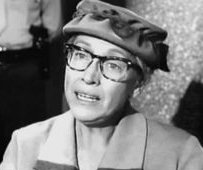
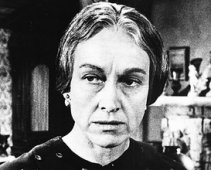 Above left: Virginia in an episode of Perry Mason, "The Case of the Pathetic Patient" (CBS, Oct 28. 1961). Above right: Virginia Gregg in Shootout At Big Sag (Parallel Films, Jun 1. 1962). |
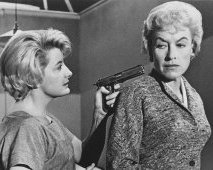
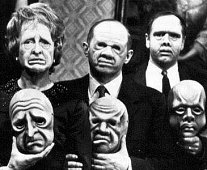 Above left: Constance Ford holding a gun to Virginia's head in House of Women (Warner Bros., Apr 11. 1962). Above right: "The Masks," an episode of The Twilight Zone (CBS, Mar 20. 1964) with Virginia Gregg (L), Milton Selzer, Alan Sues. |
|
On August 12. 1962 she married Flavius Otto Burket who not only was 12 years her junior, but as a schoolteacher an industry-outsider. Spencer's Mountain (Warner Bros., May 16. 1963) was a movie in which Virginia played the pivotal role of "Miss Parker", the teacher who tries to get a much-needed college scholarship for one of the 9 children of the Spencers (Henry Fonda and Maureen O'Hara). Again fate did not favor her. On April 25. 1965 just before the couple was to celebrate their third wedding anniversary her husband Flavius drowned on a boating trip off Point Vicente in Rancho Palos Verdes. At that time, Virginia had only just recovered from breast cancer.
She continued to work regularly for TV: Earlier she had voiced "Tarra" on the animated TV series, The Herculoids (CBS, Sep 23. - Oct 28. 1967, min. 4), and reprised that role when Hanna-Barbera revived the series as part of the Space Stars (NBC, Sep 12. - Nov 21. 1981, min. 11) animated series. Although in the 70s Virginia did acquire the proverbial "secret partner" she never remarried. |
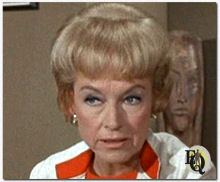 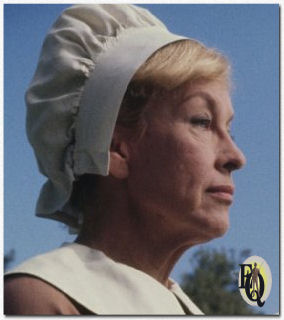 Above left: In TV's Columbo Prescription Murder (NBC, Jan 20. 1968) Above right: As Mercy Lewis in Crowhaven Farm (ABC, Nov 24. 1970). |
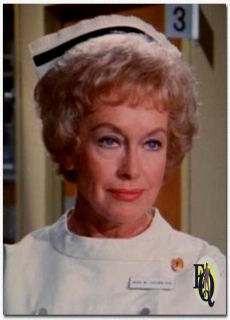 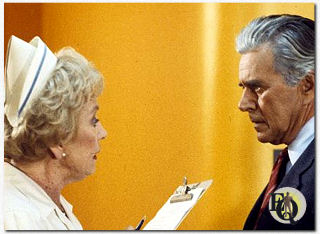 Above left: As nurse Wilma Jacobs in an episode of Emergency (NBC, 1972). Above right: Opposite Blake Carrington (John Forsythe) in Dynasty (ABC, Sep 28. 1983). |
|
At the age of 70,
Virginia Gregg,
"the actress's actress", died on September 15. 1986, in Encino, California, USA from lung cancer. Virginia said she never really wanted to be a "star" and, perhaps, she didn't quite fill today's definition of one. But she could be called a great supporting actress and without the men and women who filled the supporting roles so wondrously well, there would be very little left to hold scripts and series together. Not to mention "holding up" some of the so-called "stars"! When asked about her work, she replied: "I was very happy in radio, we were like a family, very close and caring ..." |
|
Notes: * We found a Las Vegas marriage certificate for April 8. 1948, although some sources claim they were married on October 15. 1947. All dates for movies are for the first US release. All dates for TV programs are original first airdates. All dates for (radio) plays are for the time span the actor was involved. Facts in red still need confirmation. |
|
Click on Uncle Sam if you think you can help out...!
|
|
Other references (1) Wikipedia (2) Old Time Radio column by the late Betsy W. (Betsy Weinberg) (Feb 18. 2006) (3) IMDb (4) Remembering actress Virginia Gregg, Gillum Ferguson, Daily Register 2016 (5) RUSC (6) Radiogoldindex (7) OTRRpedia (8) Uncredited: The Life and Career of Virginia Gregg Lona Bailey (Jun 30. 2022) Additional video & audio sources (1) Speaking of Radio (interview) (Audio Clip, Mar 14. 1984) (2) Perry Mason "The Case of the Cautious Coquette" (S1E18) - (Jan 18. 1958) clip YouTube - Bob Foreman (3) Virginia Gregg Tells a Funny On-The-Air Romance Story About John Dehner The Wallbreakers on Soundcloud - audioclip (4) Deep Purple - The Singing Strings audioclip with pictures (YouTube - Larry Ames) (5) Dragnet "The Big Show" (S2E11) YouTube - The Film Detective |
|
This actor profile is a part of
Ellery Queen a website on deduction.
The actor above played Nikki Porter in
an Ellery Queen radio series.
Click Uncle Sam if you think you can help
out...! Many of the profiles on this site have been compiled after very careful research of various sources. Please quote and cite ethically! |
|
Page first published on February 16. 2013 Version x2.2 - Latest update April 23. 2025 |
 b a c k
t o L i s t o f S u s p
e c t s
b a c k
t o L i s t o f S u s p
e c t s
|
|
| Introduction | Floor Plan | Q.B.I. |
List of Suspects | Whodunit? | Q.E.D. | Kill as directed | New | Copyright Copyright © MCMXCIX-MMXXV Ellery Queen, a website on deduction. All rights reserved. |